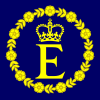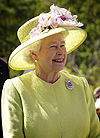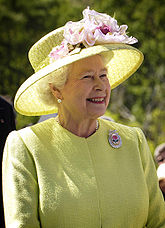- Head of the Commonwealth
-
Head of the
Commonwealth
Personal FlagTerm length Life Inaugural holder George VI Formation 28 April 1949 The Head of the Commonwealth heads the Commonwealth of Nations, an intergovernmental organisation which currently comprises 54 sovereign states. The position is currently occupied by the individual who serves as monarch of each of the Commonwealth realms, but has no day-to-day involvement in the governance of those countries, or any other Commonwealth of Nations member state. The first Head of the Commonwealth was King George VI, who was succeeded by the second and current Head of the Commonwealth, Queen Elizabeth II. The office is personal to Queen Elizabeth II and there is no agreement concerning whether the office will pass to her heir along with her other offices.
Contents
Title
The title was devised in 1949 but was not added to the monarch's style until 1953. In that year, a Royal Style and Titles Act was passed separately in each of the seven Commonwealth realms then existing (except Pakistan), which gave formal recognition to the separateness and the equality of the realms by entitling the Queen as Queen of [Realm] and her other Realms and Territories, Head of the Commonwealth.
Use in different languages
Language Title Used in Afrikaans Hoof van die Statebond (lit. Head of the Confederation) South Africa Chinese 英聯邦元首 Hong Kong (part of the Commonwealth until 1997) French Chef du Commonwealth Cameroon, Canada, Seychelles, Vanuatu, United Kingdom Crown Dependencies of Jersey and Guernsey Latin Consortionis Populorum Princeps Various (as secondary title)[1] Malay Ketua Komanwel Brunei, Malaysia, Singapore Maltese Kap tal-Commonwealth Malta Māori Upoko o Nga Herenga ki Ingarangi (lit. Leader of the links with England) New Zealand Portuguese Chefe da Commonwealth Mozambique Position
The role of the Head of the Commonwealth is recognised by its members as the "symbol of their free association" and is akin to that of a ceremonial president, but for life: unlike a chairman or secretary general of any other international organisation, the Head of the Commonwealth is a symbol of the association, playing a very important role in shaping the Commonwealth. Elizabeth II serves as a leader, with assistants that play key roles like the Commonwealth Secretary-General (currently Kamalesh Sharma) and Commonwealth Chairperson-in-Office (currently Kamla Persad-Bissessar[2]).
The Head of the Commonwealth attends the biennial Commonwealth Heads of Government Meeting (CHOGM) summits, held at locations throughout the Commonwealth, and has a series of private meetings with the Commonwealth countries' leaders, attends a CHOGM reception and dinner, and makes a speech there. The Queen or a representative (such as Prince Charles, Prince of Wales) is also present at the quadrennial Commonwealth Games and on every Commonwealth Day, the second Monday in March, broadcasts a message to all member countries.
History
The London Declaration of 1949, devised by Canadian prime minister Louis St. Laurent, states that the monarch, as a symbol of the free association of independent countries, is the Head of the Commonwealth. Republics — and kingdoms that are not Commonwealth realms — can recognise the monarch as Head of the Commonwealth without accepting the person as the country's head of state. When India adopted a republican constitution on 26 January 1950, it recognised George VI as the symbol of the association but no longer as India's head of state.
Elizabeth II became Head of the Commonwealth when she ascended to the throne in 1952. On her accession she announced, "The Commonwealth bears no resemblance to the empires of the past. It is an entirely new conception built on the highest qualities of the spirit of man: friendship, loyalty, and the desire for freedom and peace."[3]
In December 1960, the Queen had a personal flag created to symbolise her as Head of the Commonwealth and not associated with her role as queen of any particular country. Over time, the flag has replaced the British Royal Standard when the Queen visits Commonwealth countries where she is not head of state and on Commonwealth occasions in the United Kingdom. When the Queen visits the headquarters of the Commonwealth Secretariat in London, this personal standard — not any of her royal standards — is raised.[4]
List of Heads of the Commonwealth
Name Portrait Birth Death Start End George VI 
14 December 1895 6 February 1952 28 April 1949[n 1] 6 February 1952 Elizabeth II 
21 April 1926 Living 6 February 1952[n 2] Incumbent See also
- List of titles and honours of King George VI
- List of titles and honours of Queen Elizabeth II
- Commonwealth realm
- Republics in the Commonwealth of Nations
- Timeline of Commonwealth of Nations history
Notes
- ^ Based on the London Declaration and does not match his reign as king, which began on 11 December 1936.
- ^ Date of Elizabeth II's accession to the throne of the Commonwealth realms.
Footnotes
- ^ Biography of ELIZABETH II (UK), from archontology.org
- ^ Staff writer (29 May 2010). "Kamla now Commonwealth Chair". Trinidad and Tobago Newsday. http://www.newsday.co.tt/news/0,121594.html. Retrieved 29 May 2010. "The position she has inherited from former prime minister Patrick Manning following the nation’s hosting of the Commonwealth Heads of Government Meeting in November, 2009. In a statement issued yesterday, the Royal Commonwealth Society congratulated Persad-Bissessar on her appointment as Prime Minister and also praised the conduct of her election campaign."
- ^ http://www.thecommonwealth.org/Internal/34493/150757/head_of_the_commonwealth/
- ^ Royal Insight Mailbox, September 2006.
Queen Elizabeth II Monarchies - Queen of Antigua and Barbuda
- Queen of Australia
- Queen of the Bahamas
- Queen of Barbados
- Queen of Belize
- Queen of Canada
- Queen of Grenada
- Queen of Jamaica
- Queen of New Zealand
- Queen of Papua New Guinea
- Queen of Saint Kitts and Nevis
- Queen of Saint Lucia
- Queen of Saint Vincent and the Grenadines
- Queen of the Solomon Islands
- Queen of Tuvalu
- Queen of the United Kingdom
- Prime Ministers

Titles and honours - List of titles and honours
- Head of the Commonwealth
Overseas visits Public celebrations - Wedding to Philip, Duke of Edinburgh
- Coronation
- Silver Jubilee
- Golden Jubilee
- Diamond Jubilee
- Queen's Official Birthday
- Victoria Day
Categories:- Heads of the Commonwealth
- Institutions of the Commonwealth of Nations
- British monarchy
- Royal titles
- United Kingdom and the Commonwealth of Nations
Wikimedia Foundation. 2010.

